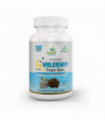Mucuna pruriens, Kapikachu or Kaunch beej is a climbing leguminous plant, that thrives in tropical environs of India, China as well as other warm locales in Asia, Africa and America. It is a leguminous food crop that belongs to the Fabaceae plant family. The plant usually reaches a height of up to 15 meters, with long, flexible branches, vivid green leaves arranged alternately and bearing white flowers. The most widely consumed part of the kaunch beej plant are the seed pods / legumes, covered by a thick hairy layer and encompassing the four to six seeds, also edible, that are dark brown in colour. Kaunch beej, originating in the wild, is a rather underrated, yet equally nourishing and proteinaceous legume. Kaunch beej is valued for its properties , where it is commonly referred to by its Sanskrit terminology Kapikacchu and supplies a rich nutrient profile when added to the regular diet.
Popularly and quite aptly dubbed as 'the magic velvet bean', 'Kevanch' as termed in Hindi, is called 'Cowhage', 'Cowitch' in English, and holds the botanical nomenclature Mucuna Pruriens. It is clad by various names including 'Poonaikali Vidai' in Tamil, 'Naikorana' in Malayalam, 'Nasugunni' in Kannada, 'Duradagondi' in Telugu and 'Kavaskuili' in Marathi. Kaunch Beej seeds and their green enclosures display a rather impressive nutritional profile, encompassing all the essential macronutrients - carbohydrates, fibers, fats and proteins, along with noteworthy levels of key micronutrients - vitamins and minerals. In addition, kaunch beej contains considerable quantities of vitamins C and E, to boost immune, skin and hair health. The B complex vitamins - thiamine, riboflavin, niacin and folic acid, as well as calcium, magnesium, iron and phosphorous, are also found in ample amounts in kaunch beej seeds.






















